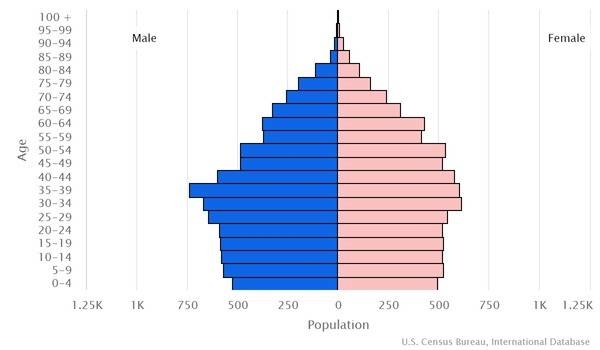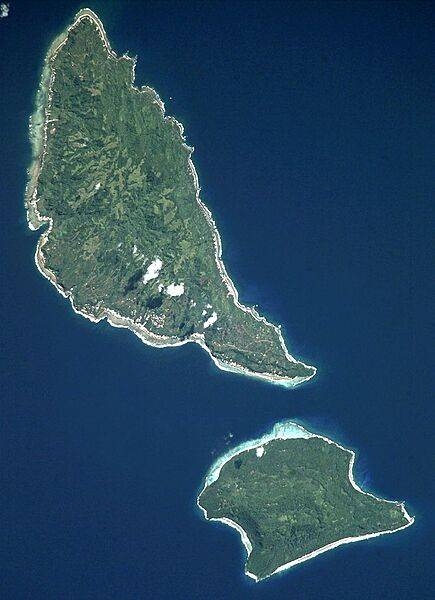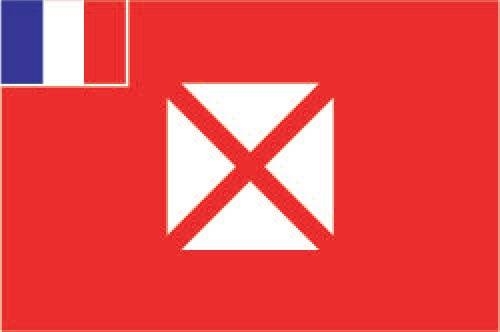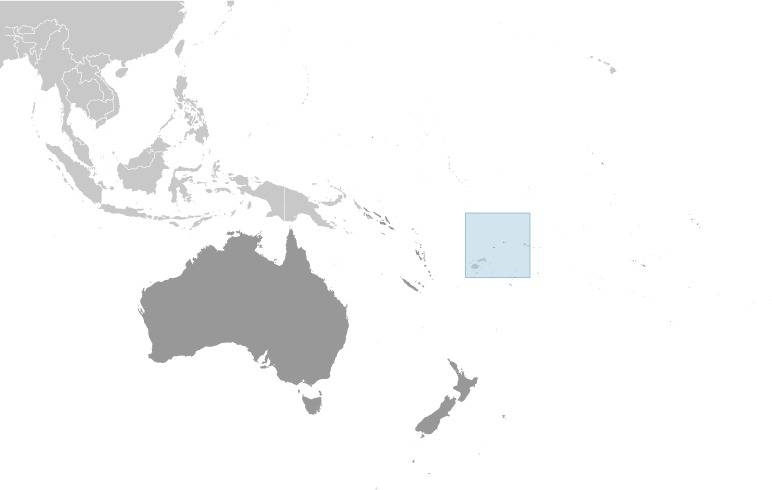Wallis and Futuna
Introduction
Background
The first humans settled Wallis and Futuna around 800 B.C. The islands were a natural midpoint between Fiji and Samoa. Around A.D. 1500, Tongans invaded Wallis and a chiefdom system resembling Tonga’s formal hierarchy developed on the island. Tongans attempted to settle Futuna but were repeatedly rebuffed. Samoans settled Futuna in the 1600s and a slightly less centralized chiefdom system formed. Dutch explorers were the first Europeans to see the islands in 1616, followed intermittently by other Europeans, including British explorer Samuel WALLIS in 1767. French Catholic missionaries were the first Europeans to permanently settle Wallis and Futuna in 1837. The missionaries converted most of the population of Wallis by 1842 and of Futuna by 1846. The missionaries and newly-converted King LAVELUA of Uvea on Wallis asked France for a protectorate in 1842 following a rebellion of locals. France agreed, although the protectorate status would not be ratified until 1887. In 1888, King MUSULAMU of Alo and King TAMOLE of Sigave, both on Futuna, signed a treaty establishing a French protectorate; the Wallis and Futuna protectorate was integrated into the territory of New Caledonia that same year. France renegotiated the terms of the protectorate with the territory’s three kings in 1910, expanding French authority.
Wallis and Futuna was the only French colony to side with the Vichy regime during World War II until the arrival of Free French and US troops in 1942. In 1959, inhabitants of the islands voted to separate from New Caledonia and become a French overseas territory, a status it assumed in 1961. Despite the split, a significant Wallisian and Futunan community still lives in New Caledonia. In 2003, Wallis and Futuna’s designation changed to that of an overseas collectivity. Wallis and Futuna became an associate member of the Pacific Islands Forum in 2018, two years after France’s other Pacific territories became full members of the organization.
Visit the Definitions and Notes page to view a description of each topic.
Geography
Location
Oceania, islands in the South Pacific Ocean, about two-thirds of the way from Hawaii to New Zealand
Geographic coordinates
13 18 S, 176 12 W
Map references
Oceania
Area
total: 142 sq km
land: 142 sq km
water: 0 sq km
note: includes Ile Uvea (Wallis Island), Ile Futuna (Futuna Island), Ile Alofi, and 20 islets
Area - comparative
1.5 times the size of Washington, DC
Land boundaries
total: 0 km
Coastline
129 km
Maritime claims
territorial sea: 12 nm
exclusive economic zone: 200 nm
Climate
tropical; hot, rainy season (November to April); cool, dry season (May to October); rains 250-300 cm per year (80% humidity); average temperature 26.6 degrees Celsius
Terrain
volcanic origin; low hills
Elevation
highest point: Mont Singavi (on Futuna) 522 m
lowest point: Pacific Ocean 0 m
Land use
agricultural land: 42.8% (2018 est.)
arable land: 7.1% (2018 est.)
permanent crops: 35.7% (2018 est.)
permanent pasture: 0% (2018 est.)
forest: 41.9% (2018 est.)
other: 15.3% (2018 est.)
Irrigated land
0.6 sq km (2020)
Natural hazards
cyclones; tsunamis
Geography - note
both island groups have fringing reefs; Wallis contains several prominent crater lakes
People and Society
Nationality
noun: Wallisian(s), Futunan(s), or Wallis and Futuna Islanders
adjective: Wallisian, Futunan, or Wallis and Futuna Islander
Ethnic groups
Polynesian
Languages
Wallisian (indigenous Polynesian language) 58.9%, Futunian 30.1%, French (official) 10.8%, other 0.2% (2003 est.)
Religions
Roman Catholic 99%, other 1%
Age structure
0-14 years: 20.58% (male 1,702/female 1,561)
15-24 years: 14.72% (male 1,238/female 1,095)
25-54 years: 43.55% (male 3,529/female 3,376)
55-64 years: 9.99% (male 745/female 842)
65 years and over: 11.73% (male 953/female 911) (2022 est.)

Dependency ratios
total dependency ratio: 57
youth dependency ratio: 36.6
elderly dependency ratio: 20.4
potential support ratio: 4.9 (2021)
Median age
total: 34 years
male: 33.1 years
female: 35.1 years (2020 est.)
Net migration rate
-3.96 migrant(s)/1,000 population (2022 est.)
note: there has been steady emigration from Wallis and Futuna to New Caledonia
Urbanization
urban population: 0% of total population (2023)
rate of urbanization: 0% annual rate of change (2020-25 est.)
Major urban areas - population
1,000 MATA-UTU (capital) (2018)
Sex ratio
at birth: 1.05 male(s)/female
0-14 years: 1.09 male(s)/female
15-24 years: 1.12 male(s)/female
25-54 years: 1.07 male(s)/female
55-64 years: 0.9 male(s)/female
65 years and over: 0.91 male(s)/female
total population: 1.06 male(s)/female (2022 est.)
Infant mortality rate
total: 4 deaths/1,000 live births
male: 3.93 deaths/1,000 live births
female: 4.07 deaths/1,000 live births (2022 est.)
Life expectancy at birth
total population: 80.67 years
male: 77.68 years
female: 83.81 years (2022 est.)
Drinking water source
improved: urban: NA
rural: 99.1% of population
total: 99.1% of population
unimproved: urban: NA
rural: 0.9% of population
total: 0.9% of population (2020)
Sanitation facility access
improved: urban: NA
rural: 92.9% of population
total: 92.9% of population
unimproved: urban: NA
rural: 7.1% of population
total: 7.1% of population (2020 est.)
Major infectious diseases
degree of risk: high (2020)
food or waterborne diseases: bacterial diarrhea
vectorborne diseases: malaria
Literacy
total population: NA
male: NA
female: NA
Environment
Environment - current issues
deforestation (only small portions of the original forests remain) largely as a result of the continued use of wood as the main fuel source; as a consequence of cutting down the forests, the mountainous terrain of Futuna is particularly prone to erosion; there are no permanent settlements on Alofi because of the lack of natural freshwater resources; lack of soil fertility on the islands of Uvea and Futuna negatively impacts agricultural productivity
Climate
tropical; hot, rainy season (November to April); cool, dry season (May to October); rains 250-300 cm per year (80% humidity); average temperature 26.6 degrees Celsius
Land use
agricultural land: 42.8% (2018 est.)
arable land: 7.1% (2018 est.)
permanent crops: 35.7% (2018 est.)
permanent pasture: 0% (2018 est.)
forest: 41.9% (2018 est.)
other: 15.3% (2018 est.)
Urbanization
urban population: 0% of total population (2023)
rate of urbanization: 0% annual rate of change (2020-25 est.)
Major infectious diseases
degree of risk: high (2020)
food or waterborne diseases: bacterial diarrhea
vectorborne diseases: malaria
Government
Country name
conventional long form: Territory of the Wallis and Futuna Islands
conventional short form: Wallis and Futuna
local long form: Territoire des Iles Wallis et Futuna
local short form: Wallis et Futuna
former: Hoorn Islands is the former name of the Futuna Islands
etymology: Wallis Island is named after British Captain Samuel WALLIS, who discovered it in 1767; Futuna is derived from the native word "futu," which is the name of the fish-poison tree found on the island
Government type
parliamentary democracy (Territorial Assembly); overseas collectivity of France
Dependency status
overseas collectivity of France
Capital
name: Mata-Utu (on Ile Uvea)
geographic coordinates: 13 57 S, 171 56 W
time difference: UTC+12 (17 hours ahead of Washington, DC, during Standard Time)
Administrative divisions
3 administrative precincts (circonscriptions, singular - circonscription) Alo, Sigave, Uvea
Independence
none (overseas collectivity of France)
National holiday
Bastille Day, 14 July (1789)
Constitution
history: 4 October 1958 (French Constitution)
amendments: French constitution amendment procedures apply
Legal system
French civil law
Citizenship
see France
Suffrage
18 years of age; universal
Executive branch
chief of state: President Emmanuel MACRON (since 14 May 2017); represented by Administrator Superior Herve JONATHAN (since 11 January 2021)
head of government: President of the Territorial Assembly Munipoese MULI'AKA'AKA (since 20 March 2022)
cabinet: Council of the Territory appointed by the administrator superior on the advice of the Territorial Assembly
elections/appointments: French president elected by absolute majority popular vote in 2 rounds if needed for a 5-year term (eligible for a second term); administrator superior appointed by the French president on the advice of the French Ministry of the Interior; the presidents of the Territorial Government and the Territorial Assembly elected by assembly members
note: there are 3 traditional kings with limited powers
Legislative branch
description: unicameral Territorial Assembly or Assemblee Territoriale (20 seats - Wallis 13, Futuna 7; members directly elected in multi-seat constituencies by party-list proportional representation vote to serve 5-year terms)
Wallis and Futuna indirectly elects 1 senator to the French Senate by an electoral college by absolute majority vote in 2 rounds if needed for a 6-year term, and directly elects 1 deputy to the French National Assembly by absolute majority vote for a 5-year term
elections: Territorial Assembly - last held on 20 March 2022 (next to be held in March 2027)
French Senate - last held on 24 and 27 September 2020 (next to be held by September 2023)
French National Assembly - last held on 11 June 2017 (next to be held in June 2022)
election results: Territorial Assembly - percent of vote by party - NA; seats by party - 2 members are elected from the list Ofa mo'oni ki tou fenua and 2 members are elected from list Mauli fetokoniaki, 1 seat each from 16 other lists; composition - men NA, women NA, percent of women NA%
representation in French Senate - LR 1 (man)
representation in French National Assembly - independent 1 (man)
Judicial branch
highest court(s): Court of Assizes or Cour d'Assizes (consists of 1 judge; court hears primarily serious criminal cases); note - appeals beyond the Court of Assizes are heard before the Court of Appeal or Cour d'Appel (in Noumea, New Caledonia)
judge selection and term of office: NA
subordinate courts: courts of first instance; labor court; note - justice generally administered under French law by the high administrator, but the 3 traditional kings administer customary law, and there is a magistrate in Mata-Utu
Political parties and leaders
Left Radical Party or PRG [Guillaume LACROIX] (formerly Radical Socialist Party or PRS and the Left Radical Movement or MRG)
Lua Kae Tahi (Giscardians) (leader NA)
Rally for Wallis and Futuna-The Republicans (Rassemblement pour Wallis and Futuna) or RPWF-LR [Clovis LOGOLOGOFOLAU]
Socialist Party or PS
Taumu'a Lelei [Soane Muni UHILA]
Union Pour la Democratie Francaise or UDF
International organization participation
PIF (observer), SPC, UPU
Diplomatic representation in the US
none (overseas collectivity of France)
Diplomatic representation from the US
none (overseas collectivity of France)
Flag description
unofficial, local flag has a red field with four white isosceles triangles in the middle, representing the three native kings of the islands and the French administrator; the apexes of the triangles are oriented inward and at right angles to each other; the flag of France, outlined in white on two sides, is in the upper hoist quadrant
note: the design is derived from an original red banner with a white cross pattee that was introduced in the 19th century by French missionaries; the flag of France is used for official occasions
National symbol(s)
red saltire (Saint Andrew's Cross) on a white square on a red field; national colors: red, white
Economy
Economic overview
The economy is limited to traditional subsistence agriculture, with about 80% of labor force earnings coming from agriculture (coconuts and vegetables), livestock (mostly pigs), and fishing. However, roughly 70% of the labor force is employed in the public sector, although only about a third of the population is in salaried employment.
Revenues come from French Government subsidies, licensing of fishing rights to Japan and South Korea, import taxes, and remittances from expatriate workers in New Caledonia. France directly finances the public sector and health-care and education services. It also provides funding for key development projects in a range of areas, including infrastructure, economic development, environmental management, and health-care facilities.
A key concern for Wallis and Futuna is an aging population with consequent economic development issues. Very few people aged 18-30 live on the islands due to the limited formal employment opportunities. Improving job creation is a current priority for the territorial government.
GDP (official exchange rate)
$195 million (2005) (2005)
GDP - composition, by sector of origin
agriculture: NA
industry: NA
services: NA
GDP - composition, by end use
household consumption: 26% (2005)
government consumption: 54% (2005)
Agricultural products
coconuts, breadfruit, yams, taro, bananas; pigs, goats; fish
Industries
copra, handicrafts, fishing, lumber
Labor force - by occupation
agriculture: 74%
industry: 3%
services: 23% (2015 est.)
Household income or consumption by percentage share
lowest 10%: NA
highest 10%: NA
Budget
revenues: 32.54 million (2015 est.) NA
expenditures: 34.18 million (2015 est.) NA
Public debt
5.6% of GDP (2004 est.)
note: offical data; data cover general government debt and include debt instruments issued (or owned) by government entities other than the treasury; the data include treasury debt held by foreign entities; the data include debt issued by subnational entities, as well as intragovernmental debt; intragovernmental debt consists of treasury borrowings from surpluses in the social funds, such as for retirement, medical care, and unemployment; debt instruments for the social funds are not sold at public auctions
Fiscal year
calendar year
Exports - partners
Singapore 47%, France 32%, Belgium 9% (2019)
Exports - commodities
integrated circuits, jewelry, cars, aircraft parts, polyacetals (2019)
Imports - partners
France 43%, Fiji 24%, New Zealand 11%, Australia 6% (2019)
Imports - commodities
refined petroleum, beef products, poultry meats, engine parts, packaged medicines (2019)
Exchange rates
Comptoirs Francais du Pacifique francs (XPF) per US dollar -
110.2 (2015 est.)
89.8 (2014 est.)
89.85 (2013 est.)
90.56 (2012 est.)
Communications
Telephones - fixed lines
total subscriptions: 3,132 (2018 est.)
subscriptions per 100 inhabitants: 25 (2018 est.)
Telephones - mobile cellular
total subscriptions: 0 (2018)
subscriptions per 100 inhabitants: 0 (2019)
Telecommunication systems
general assessment: 2G widespread; bandwidth is limited; mobile subscriber numbers are higher than fixed-line and better suited for islands; good mobile coverage in the capital cities and also reasonable coverage across more remote atolls; recent international interest in infrastructure development; increase in demand for mobile broadband as mobile services serve as primary source for Internet access; broadband satellite launched in 2019 to improve costs and capability (2020)
domestic: fixed-line teledensity 25 per 100 persons and 0 per 100 mobile subscriptions (2019)
international: country code - 681; landing point for the Tui-Samoa submarine cable network connecting Wallis & Futuna, Samoa and Fiji (2020)
note: the COVID-19 pandemic continues to have a significant impact on production and supply chains globally; since 2020, some aspects of the telecom sector have experienced a downturn, particularly in mobile device production; progress toward 5G implementation has resumed, as well as upgrades to infrastructure; consumer spending on telecom services has increased due to the surge in demand for capacity and bandwidth; the crucial nature of telecom services as a tool for work and school from home is still evident, and the spike in this area has seen growth opportunities for development of new tools and increased services
Broadcast media
the publicly owned French Overseas Network (RFO), which broadcasts to France's overseas departments, collectivities, and territories, is carried on the RFO Wallis and Fortuna TV and radio stations (2019)
Internet users
total: 1,029 (2019 est.)
percent of population: 9% (2019 est.)
Transportation
Airports - with paved runways
total: 2
1,524 to 2,437 m: 1
914 to 1,523 m: 1 (2021)
Ports and terminals
major seaport(s): Leava, Mata-Utu
Military and Security
Military - note
defense is the responsibility of France
Transnational Issues
Disputes - international
none identified



